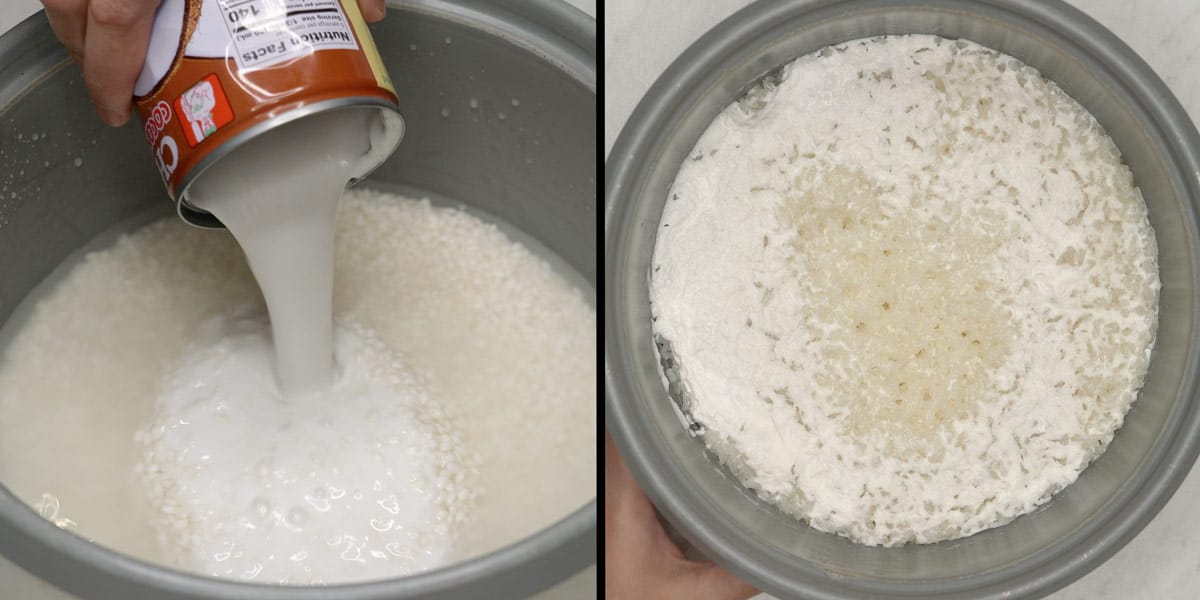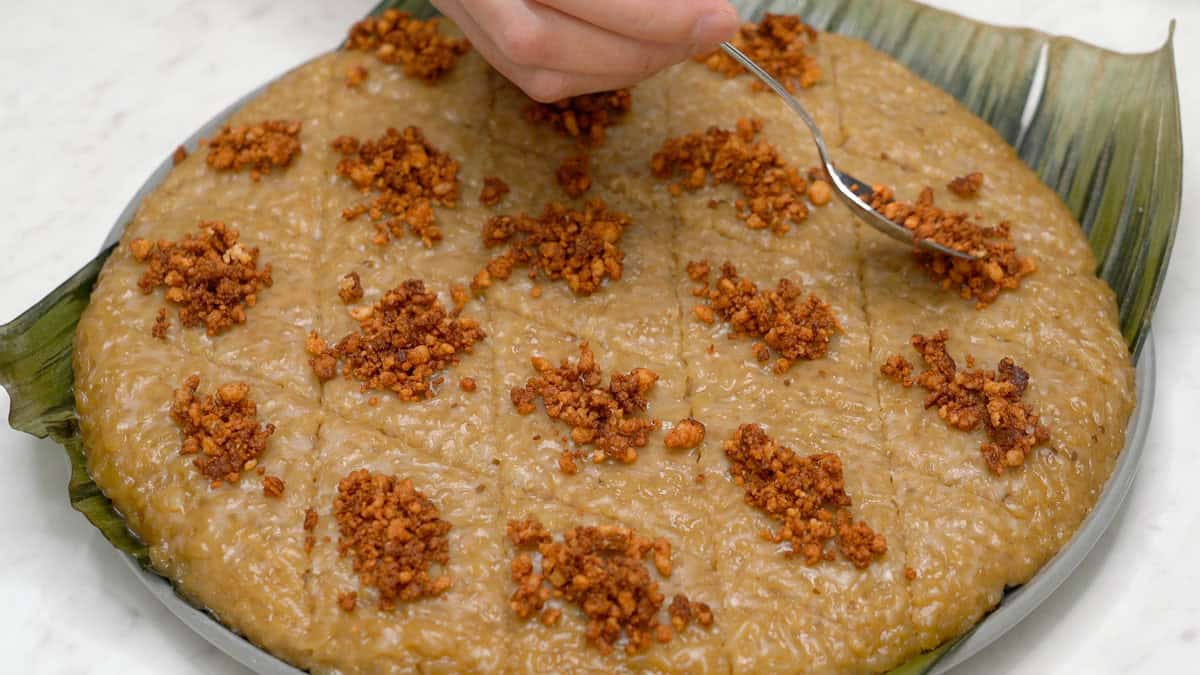This Filipino sticky rice cake is made with coconut milk and panutsa (jaggery), then topped with crispy, toasty latik. With just basic ingredients and a little patience, this easy Biko recipe comes together in no time!

Jump to:
What is Biko?
Biko is a traditional Filipino rice cake (kakanin) made with glutinous rice, coconut milk, and muscovado or brown sugar. It is soft and chewy with a rich, caramel-like sweetness. The coconut milk adds a slightly nutty, creamy flavor.
It's topped with latik curds—crispy golden-brown bits formed by simmering coconut milk until the oil separates. These add a crunchy texture and extra coconut flavor.

Some versions use latik syrup, a thick coconut caramel sauce made by reducing coconut milk with dark sugar. While some drizzle it over Biko, it’s more commonly used on Bibingkang Malagkit and other sticky rice cakes.
Biko is also known as sinukmani or inkiwar in other parts of the Philippines. It’s often served in a bilao (a round woven tray) and enjoyed as a snack, a special treat, or just because!
Ingredients you'll need

Notes and substitutions
- Glutinous rice: This is also known as malagkit, sweet rice, or sticky rice. This type of rice becomes soft, chewy, and sticky when cooked. Despite its name, it doesn’t contain gluten or sugar.
- Coconut milk: Fresh is best, but I usually use canned since it’s easier to find. You can also use coconut cream (kakang gata) for a thicker consistency.
- Panutsa: This is a type of unrefined sugar made by boiling sugarcane juice until it thickens and hardens into discs or blocks. It gives Biko a deep caramel flavor and golden-brown color. You can substitute it with dark brown sugar or muscovado sugar.
- Anise seeds: These are small, oval seeds with a sweet, licorice-like taste. Not everyone likes the flavor, but I enjoy it because it adds a warm, fragrant touch. You can also use ginger, vanilla extract, or pandan extract if you want a hint of extra flavor or aroma.
How to make this recipe
Step 1: Cook the rice
In a pot, rinse 2 cups of glutinous rice to wash away excess starch. Add 1 cup of water, 1 cup of coconut milk from the can (save the rest for later), and a pinch of salt.
Cook it as you normally would—bring it to a boil over medium-high heat, then lower the heat to medium-low. Cover and let it simmer for about 20 minutes, or until the liquid is absorbed. You can use a rice cooker if you prefer.
Do not overcook it—the rice should be tender and sticky, not mushy. Once done, remove the lid right away to let the steam escape. Let it cool completely.

Step 2: Make the latik (coconut curds)
Pour 1 can of coconut milk (about 1½ cups) into a pan. Let it boil for about 20 minutes over medium-high heat, stirring it now and then to prevent burning.
When it thickens, lower the heat to medium and stir often. Keep cooking for another 5–10 minutes until the oil starts to separate and the curds turn golden and crispy.
Once they’re done, quickly drain the curds from the oil—they can brown or burn from the leftover heat. Set it aside for topping later.
For a more detailed guide on making latik, check out this step-by-step recipe.

Step 3: Prepare the serving platter
Biko is traditionally served in a bilao (a round bamboo tray) lined with banana leaves, but any flat tray or plate will work. To soften the leaves and bring out their aroma, quickly run them over a flame. Then, brush them with latik oil to keep the Biko from sticking.

Step 4: Chop the panutsa
Cut the panutsa into small pieces so it melts faster and more evenly when you cook it. It’s usually sold in solid blocks or discs, so breaking it up makes it easier to work with.

Step 5: Prepare the coconut milk mixture
In a non-stick pan, pour in the remaining ½ cup of coconut milk from earlier plus a full can of coconut milk—making a little over 2 cups in total. Add 8 ounces of panutsa (broken into pieces), ½ teaspoon anise seeds, and a good pinch of salt.
Bring it to a boil over medium-high heat, stirring occasionally. Let it cook for about 15 minutes, or until the mixture slightly thickens and turns a deep caramel color.

Step 6: Cook the rice mixture
Add the cooled rice and stir well until evenly coated. Cook for about 20 minutes, stirring continuously to prevent burning.
As it cooks, you'll notice it becoming slightly oily—this is the coconut milk cooking down. It's ready when it forms a thick, sticky mass that pulls away from the pan and feels harder to stir. The texture should be soft and chewy, not mushy.

Step 7: Spread the rice mixture
Transfer the sticky rice mixture to your platter lined with banana leaves. Spread it evenly using a spatula or the back of a spoon.
Gently press down and smooth the top, making sure it's packed evenly. Brush the top with latik oil to keep it from drying out—it also adds a nice shine and that extra hint of coconut aroma.

Step 8: Slice and add the topping
Let the Biko cool slightly, then slice it into diamond or square pieces using a greased knife or dough/bench scraper. Then, generously top each piece with latik. Enjoy your delicious treat!

To store leftovers, keep them covered with plastic wrap at room temperature for up to a day, or in an airtight container in the fridge for up to 3 days. Reheat gently before serving, or enjoy at room temperature.

Recipe FAQs
Latik is a sweet topping made from coconut milk and comes in two forms: toasted latik, which are crunchy, golden-brown coconut curds made by simmering coconut milk until it separates and crisps, and caramelized latik sauce, a smooth and sweet coconut caramel syrup made by cooking coconut milk with brown sugar.
Granulated sugar isn't recommended for Biko because it results in a lighter color and milder flavor. Brown sugar, muscovado, panutsa, or coconut sugar are better options, as they provide a richer flavor and darker color.
More Filipino rice cakes
- Bibingkang Malagkit: Sweet rice cake made with glutinous rice and coconut milk, topped with latik syrup.
- Ube Kalamay: Purple rice cake made with purple yam (ube), glutinous rice flour, and coconut milk, often topped with latik curds.
- Ube Suman sa Latik: Steamed rice cakes with ube and latik wrapped in banana leaves.
- Espasol: Rice cakes made with glutinous rice flour and coconut milk, then dusted with toasted rice flour. Ube Espasol is a variation made with ube.
- Palitaw: Boiled rice cakes coated with grated mature coconut, sugar, and sesame seeds or peanuts.
- Puto: Steamed rice cakes made with rice flour, sometimes with coconut milk.
- Suman: Boiled rice cakes wrapped in banana leaves.
- Sapin-Sapin: A colorful, layered dessert made with glutinous rice flour, coconut milk, and different flavors.
Other dessert recipes you may like

Did you make this recipe? I would love to know! Your feedback helps me make better recipes. Please rate, review, or comment below. Questions about this recipe are welcome, too!
Let's connect on Facebook, Instagram, Pinterest, TikTok, Twitter, and Youtube. Be sure to tag me when you try any of my recipes @recipesbynora!
📖 Recipe

Biko
Equipment
- Pot or rice cooker
- 11-inch round plate or any flat tray of a similar size
- Wok or large pan (non-stick)
- Non-stick pan (for making latik)
- Fine-mesh strainer or slotted spoon
Ingredients
For the Biko:
- 2 cups glutinous rice (see note)
- 1 cup water
- 2 (13.5-oz) cans coconut milk (about 3 cups) divided (see note)
- 8 ounces panutsa (see note)
- ½ teaspoon anise seeds optional (see note)
- Salt
For the latik:
- 1 (13.5-oz) can coconut milk (see note)
Instructions
- Cook the rice: Rinse 2 cups of rice a few times, then drain. Add 1 cup of water, 1 cup of coconut milk from the can (save the rest for later), and a pinch of salt.Bring to a boil over medium-high heat. Once boiling, reduce to low. Cover and cook for 15–20 minutes, until the liquid is absorbed. When it's done, remove the lid right away to release steam and let the rice cool completely. (You can also use a rice cooker.)
- Make the latik: Boil 1 can of coconut milk in a pan over medium-high heat for 20 minutes, scraping the bottom and sides occasionally. Once thickened, lower the heat to medium. Stir frequently until the oil separates and the curds turn golden and crispy. Drain quickly and set aside.
- Prepare the serving platter: Line a tray or platter with banana leaves softened over a flame. Brush with latik oil to prevent sticking.
- Chop the panutsa: Cut 8 ounces panutsa into small pieces for easier melting.
- Prepare the coconut milk mixture: In a pan, combine the remaining ½ cup coconut milk, 1 full can coconut milk (a little over 2 cups total), panutsa, anise seeds, and a good pinch of salt. Cook over medium-high heat for about 15 minutes, stirring occasionally, until slightly thickened and caramel-colored.
- Cook the rice mixture: Add the cooled rice and stir continuously for about 20 minutes until thick, slightly oily, and harder to stir. The texture should be soft and chewy, but not mushy.
- Spread the rice mixture: Transfer the rice onto the platter. Spread evenly and press gently to smooth the surface. Brush the top with latik oil to keep it from drying out.
- Slice and add the topping: Cool slightly, then slice into diamond or square pieces. Top generously with crispy latik.











Joyce
Wow! This is different from other biko i’ve tried. Soo delicious. Soft, chewy and the flavor is amazing. Thank you for the recipe Ms. Nora!
Nora Reyes
Hello Joyce! I am so glad you enjoyed it. Thank you for trying out the recipe!